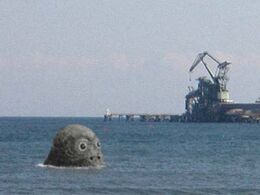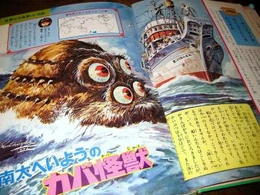The Kabagon (カバゴン) is a cryptid first spotted by the crew of the Japanese fishing ship 28th Konpiramaru (第二十八金毘羅丸) in 1974 off Lyttleton, New Zealand.
Name
The name "Kabagon" literally means "hippo monster" in the Japanese language. The naming was said to be "on impulse".
Descriptions
The most notable features of the creature are very large eyes and nostrils, and a large head measuring 1.5 meters in height from under the nostrils to the top of the head. Its coloration is grayish. In general, the head of the creature somewhat resembles Umi bōzu.
History

In the afternoon of April 28, 1974, at about 7:00 PM, all 26-28 crew members including captain Kimura of the Japanese fishing vessel 28th Konpiramaru from Mekawa, Miyagi witnessed a large creature off Lyttleton Peninsula.[1][2][3] Only the 1.5 meters tall head of the creature was observed, and the creature dived after watching the crew for a while. Captain Kimura sketched the animal (above).
The local New Zealand Weekly Magazine later picked up this sighting and mysterious footprints were reported on a beach near the sighting location.
Some consider that this animal may belong to the same species as the Large Antarctic Sea Mammal aka "Antarctic Godzilla".
Hypothesis

Kabagon was initially speculated as a misidentification of pinnipeds,[4] most likely walruses, however the latter was denied as the species only inhabits the Arctic waters of the northern hemisphere. Some indicate that the creature is a remnant descendant of Desmostylidae.
However, the descriptions of the creature actually fit several species of pinnipeds such as the leopard seal and the southern elephant seal. Especially, the southern elephant seal, the largest of living pinnipeds reaching 5 to 6.5 meters in length, can be a possible candidate for this record. Around the globe, there are many similar cases involving possible misidentifications of elephant seals such as Helena Manatee, Bunyip, Steller's Sea Cow sightings.